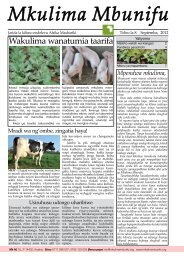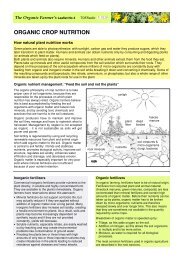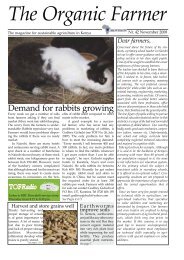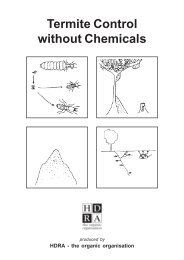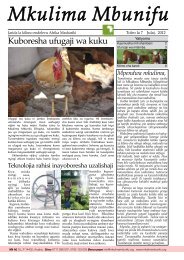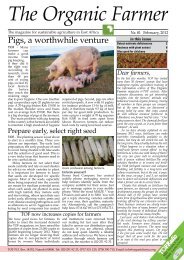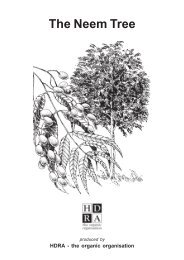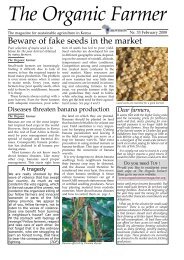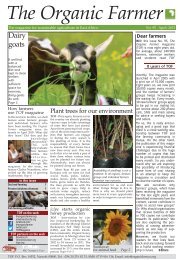TOF Module No 06, Green manure, cover crops ... - Infonet-Biovision
TOF Module No 06, Green manure, cover crops ... - Infonet-Biovision
TOF Module No 06, Green manure, cover crops ... - Infonet-Biovision
- No tags were found...
Create successful ePaper yourself
Turn your PDF publications into a flip-book with our unique Google optimized e-Paper software.
Some things to consider• If residues of <strong>crops</strong> or <strong>cover</strong> <strong>crops</strong> are left on the soil surface, they decompose slowly and nutrients are also releasedslowly. The soil is <strong>cover</strong>ed and protected for a long time, which is beneficial.• Diseases and pests may survive in crop residues. To prevent accumulation, it is essential to practise crop rotation.• For decomposition of large amounts of woody materials such as straw or stalks, soil microorganisms need nitrogenwhich will then be temporarily unavailable for plant growth. It can be beneficial to topdress some nitrogen rich fertilizerif you feel that <strong>crops</strong> are suffering from lack of nitrogen because of the mulch.• When young green <strong>manure</strong> <strong>crops</strong> are incorporated into the soil before planting, there is a rapid development of soilorganisms. They quickly break the soft material down and large amounts of nutrients are released. The smallseedlings are not able to take them all up, resulting in nutrient losses through leaching. In addition, there is a dangerof erosion as the soil is not protected by a plant canopy after incorporation and during crop establishment.• If a legume species is grown in a field for the first time, inoculation of the seeds with suitable Rhizobium bacteria maybe necessary to make nitrogen fixation possible. Bacteria should be available from the seed supplier.Some practical aspects<strong>Green</strong> <strong>manure</strong>s as a sole crop to improve soil fertilityIn regions like Kakamega where the second rainy season isunreliable or short, plant maize as a pure stand during the longrains. After the maize harvest, plant green <strong>manure</strong> legumes andleave them in the field during the dry season. Slash and incorporatethem during land preparation before the next long rains.Intercropping green <strong>manure</strong> legumes with maizeIn regions with two longer rainy season per year, green <strong>manure</strong>legumes are usually planted at the same time as maize. Veryvigorous species like mucuna and lablab should be sown 2 to 4weeks later to give the main crop an advantage. Do a weeding ifnecessary. The legume is planted in between maize rows andleft to grow during the dry season. It is slashed and incorporatedinto the soil at the beginning of the next rainy season.In regions like Kitale with only one long rainy season per year,legume <strong>cover</strong> <strong>crops</strong> are planted between the maize rows inAugust, about 4 months after planting maize. The lower maizeleaves are stripped (they are an excellent fodder for dairyanimals!) to allow better legume establishment. The legume isslashed and incorporated into the topsoil only 2 to 3 weeksbefore planting the next crop.Intercropping green <strong>manure</strong>s with vegetablesLegumes can also be intercropped with vegetables like kales.Choose a legume that grows upright and does not coil aroundthe vegetables, e.g. crotalaria or Jackbean (canavalia).Cover <strong>crops</strong> for conservation agricultureCover <strong>crops</strong> are a central element in conservation agriculture.Even in drier regions like Machakos district, suitable <strong>cover</strong> <strong>crops</strong>like lablab provide complete ground <strong>cover</strong> within three months.The legume plants are left on the surface as mulch and the nextcrop is planted directly through the mulch layer.<strong>Green</strong> <strong>manure</strong>s from shrubs and treesTithonia is one of the most effective green <strong>manure</strong>plants as it decays quickly and grows in manyregions in Kenya (see picture above). Chop theyoung shoots before flowering and incorporatethem into the topsoil (3 to 5 kg / square meter) 1-2weeks before planting or transplanting a vegetable.Working green <strong>manure</strong>s into the soil<strong>Green</strong> <strong>manure</strong> plants are worked in when they arestill young and fresh. It is preferable to chop themto allow easier decomposition. The older theplants, the longer decomposition will take.Cover <strong>crops</strong> in plantations and forestablishment of plantation <strong>crops</strong>In plantations (coffee, tea, coconut, citrus,sugarcane etc.), <strong>cover</strong> <strong>crops</strong> provide excellentground <strong>cover</strong> for weed suppression, control of soilerosion and a good soil climate for growth.Mulching in high value <strong>crops</strong>Mulching is often used for young plants in vegetable production to conservesoil moisture and to provide a good soil climate. The mulch material is spreadby hand or with a rake in a layer 1 to 4 inches thick. In a wet climate, only thinlayers should be used, while in a dry climate, thicker layers can be applied.Wet green material should be allowed to dry and wilt before application.Tithonia provides very good mulch – and nutrientsWhere Tithonia is applied as mulch, plants show increased growth rates.Plant Tithonia in hedges around your fields! They can be pruned several timesa year about knee high above the ground. Cut the shoots before flowering andwhen they are about 2 m high. Chop them and spread a layer of about twoinches around the plants or all over the bed.Banana mulchMulch should be applied about 60 - 90 cm away from banana stools in order to encourage growth of deep vertical roots.When mulch is applied close to the stool, more superficial lateral roots develop. The plants will suffer during dry spells,and there is a risk that stems are uprooted in strong wind.




